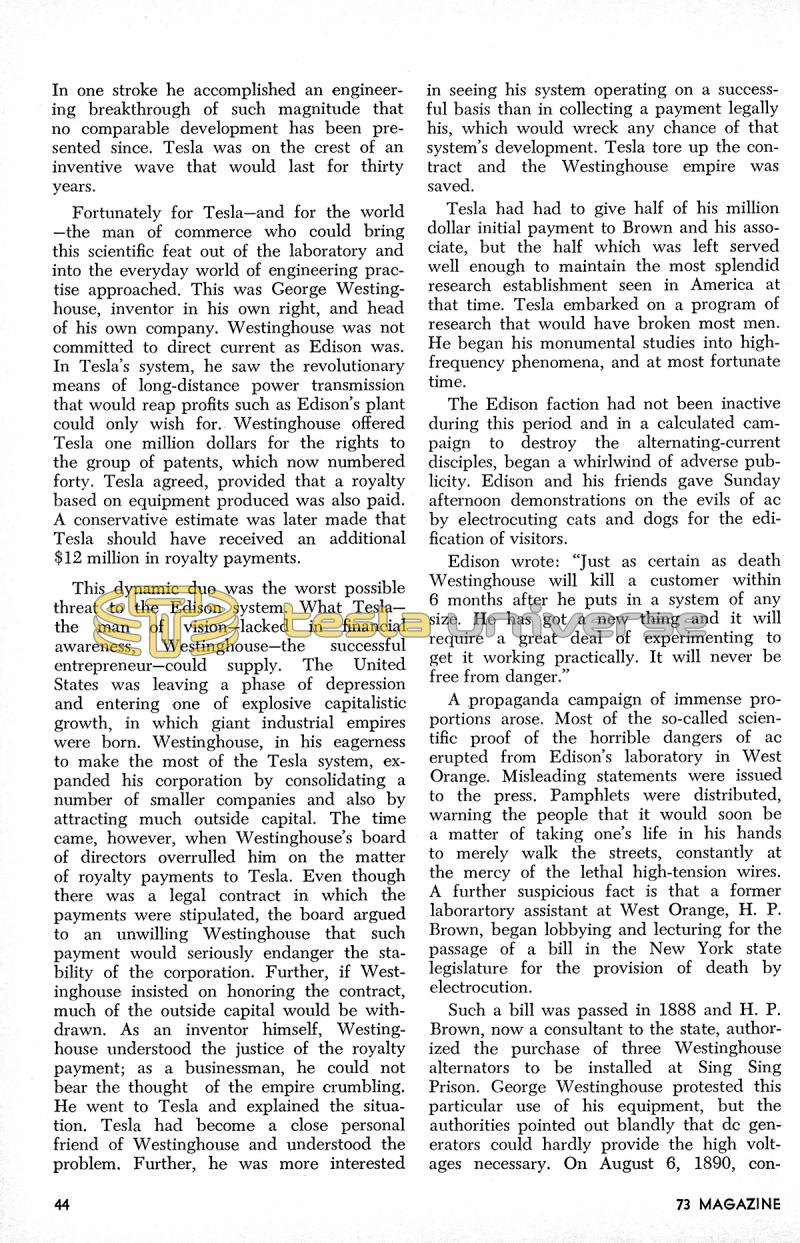
Nikola Tesla Articles
In one stroke he accomplished an engineering breakthrough of such magnitude that no comparable development has been presented since. Tesla was on the crest of an inventive wave that would last for thirty years.
Fortunately for Tesla - and for the world - the man of commerce who could bring this scientific feat out of the laboratory and into the everyday world of engineering practice approached. This was George Westinghouse, inventor in his own right, and head of his own company. Westinghouse was not committed to direct current as Edison was. In Tesla's system, he saw the revolutionary means of long-distance power transmission that would reap profits such as Edison's plant could only wish for. Westinghouse offered Tesla one million dollars for the rights to the group of patents, which now numbered forty. Tesla agreed, provided that a royalty based on equipment produced was also paid. A conservative estimate was later made that Tesla should have received an additional $12 million in royalty payments.
This dynamic duo was the worst possible threat to the Edison system. What Tesla - the man of vision - lacked in financial awareness, Westinghouse - the successful entrepreneur - could supply. The United States was leaving a phase of depression and entering one of explosive capitalistic growth, in which giant industrial empires were born. Westinghouse, in his eagerness to make the most of the Tesla system, expanded his corporation by consolidating a number of smaller companies and also by attracting much outside capital. The time came, however, when Westinghouse's board of directors overruled him on the matter of royalty payments to Tesla. Even though there was a legal contract in which the payments were stipulated, the board argued to an unwilling Westinghouse that such payment would seriously endanger the stability of the corporation. Further, if Westinghouse insisted on honoring the contract, much of the outside capital would be withdrawn. As an inventor himself, Westinghouse understood the justice of the royalty payment; as a businessman, he could not bear the thought of the empire crumbling. He went to Tesla and explained the situation. Tesla had become a close personal friend of Westinghouse and understood the problem. Further, he was more interested in seeing his system operating on a successful basis than in collecting a payment legally his, which would wreck any chance of that system's development. Tesla tore up the contract and the Westinghouse empire was saved.
Tesla had had to give half of his million dollar initial payment to Brown and his associate, but the half which was left served well enough to maintain the most splendid research establishment seen in America at that time. Tesla embarked on a program of research that would have broken most men. He began his monumental studies into high-frequency phenomena, and at most fortunate time.
The Edison faction had not been inactive during this period and in a calculated campaign to destroy the alternating-current disciples, began a whirlwind of adverse publicity. Edison and his friends gave Sunday afternoon demonstrations on the evils of ac by electrocuting cats and dogs for the edification of visitors.
Edison wrote: "Just as certain as death Westinghouse will kill a customer within 6 months after he puts a system of any size. He has got a new thing and it will require a great deal of experimenting to get it working practically. It will never be free from danger."
A propaganda campaign of immense proportions arose. Most of the so-called scientific proof of the horrible dangers of ac erupted from Edison's laboratory in West Orange. Misleading statements were issued to the press. Pamphlets were distributed, warning the people that it would soon be a matter of taking one's life in his hands to merely walk the streets, constantly at the mercy of the lethal high-tension wires. A further suspicious fact is that a former laborartory assistant at West Orange, H. P. Brown, began lobbying and lecturing for the passage of a bill in the New York state legislature for the provision of death by electrocution.
Such a bill was passed in 1888 and H. P. Brown, now a consultant to the state, authorized the purchase of three Westinghouse alternators to be installed at Sing Sing Prison. George Westinghouse protested this particular use of his equipment, but the authorities pointed out blandly that de generators could hardly provide the high voltages necessary. On August 6, 1890, con-
